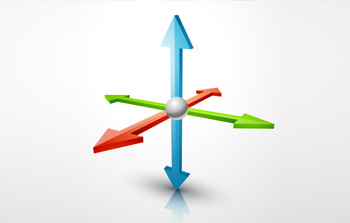The X-Y-Z Framework for Product Management

"What is your product roadmap?”
 It’s one of the biggest questions you get at an enterprise software company, and rightfully so. Customers have their wish lists. Analysts need to place you in the competitive landscape. And you have to keep innovating. The entire company could be at stake if you get this wrong. So how do you prioritize features or enhancements to build?
It’s one of the biggest questions you get at an enterprise software company, and rightfully so. Customers have their wish lists. Analysts need to place you in the competitive landscape. And you have to keep innovating. The entire company could be at stake if you get this wrong. So how do you prioritize features or enhancements to build?
Throughout my career, I’ve used a three-part framework: Customers, innovation and market opportunity. These are collectively exhaustive. Think about them as ‘X’, ‘Y’ and ‘Z’ axes in three-dimensional space.
Setting product roadmap priorities is an art, not a science, and the art is in balancing your priorities along these three dimensions within each product release. This takes vision and leadership, grounded in a broad and deep understanding your products, your customers and your market.
Dimension X: Customers
Along the ‘X’ axis, we have customers. Listening to them is critical, but you have to listen for the patterns in what they’re asking for and not get too bogged down in specifics. It’s up to you to figure out what makes sense and will appeal to the broadest audience. You’ll notice the iPhone only comes in a few sizes and colors. They could easily have built it in more, but they’re not trying to be all things to all people.
For an enterprise software company, figuring out this dimension gets easier as your customer base grows. Early in the product lifecycle, it’s more artistic in the sense that you're using your own intuition. Later, you can have customer communities where people suggest ideas and vote on them. These communities and their votes can help guide your thinking.
What gets the most votes should have high priority for development, with the caveat that although every customer may have a vote, not all votes count the same. You have to apply judgement and consider the realities of the business.
If two customers who are each paying a $100,000 annual subscription fee both want a particular feature, their vote should probably count more than one customer paying $50,000. But if ten customers paying $50,000 want something, you have to listen to that as well. It’s democratic, in the way the House of Representatives is democratic. Some states have more representation than others. But ultimately, what is best for the entire country (or company) over the long term must also be considered.
Dimension Y: Innovation
You simply can’t rely on the customer for innovation. Turn of the century automotive pioneer Henry Ford is credited with saying, “If I had asked my customers what they wanted, they would have said a faster horse.” Like Ford, it’s your job to see what the customer cannot.
Your company and product leadership always have to be scanning the market for developing technological innovations. You should go to tradeshows, monitor the funding landscape and look at new technology that may not even be in your space to see if it’s applicable to your product. Talk to suppliers, and look at deals you've lost, and why you've lost them. Then think creatively about new technology that’s out there.
Dimension Z: Market
You also have to be looking at what’s going on in your own market. What are your competitors doing? Are there things that are ancillary to your business or complementary to your core competencies that could attract new customers and increase wallet share with existing ones?
If you have a lemonade stand, and some kid opens an iced tea stand on the opposite corner and is doing brisk business, make your own iced tea. You’ve got the stand, the cups and the water. Buy some tea bags along with your lemons next time. And while you’re at it, why not one up the other kid and sell Arnold Palmers too?
A balanced approach
With every release you have to consider each of those three dimensions, giving the highest priority to development projects where all three axes intersect. At the same time, you have to keep all three in balance.
With some releases, you might tilt a little more towards customers, because there’s something they’re clamoring for. Sometimes you might lean toward innovation because you want to be the first to launch. You might lean more toward market because you see a huge opportunity in an ancillary space. But you can never ignore any dimension or you risk becoming the next Blockbuster, or taxicab company.
It is now well known that Blockbuster focused too much on the customer dimension, trying to generate add-on revenue from their existing bricks-and-mortars customer base, and missed the video-on-demand innovation cycle in their industry. Precise geolocation technology has been widely available for some time now; taxicab companies could have done what Uber did, but they haven’t.
Or consider Coghead. They were a platform-as-a-service in the early days of the platform economy. Their innovation was spot-on; today platform businesses are soaring. But Coghead didn’t focus on any particular customer or market segment. They had cool technology, but they missed those other pieces so the innovation went nowhere.
There are many examples of companies that innovate but don't think about the customer or the marketplace and they implode on themselves. Or, they focus so much on the customer that they become a custom development shop, or professional services firm for a few big customers but they never scale and grow.
The disciplined application of a product management framework such as the X-Y-Z provides the scientific boundaries inside of which product artistry can take place. It keeps you focused and balanced and helps you ensure that your product stays vibrant, and relevant, over the long term. Who knows, it might even help you win a market.
This article previously appeared on EBNOnline.